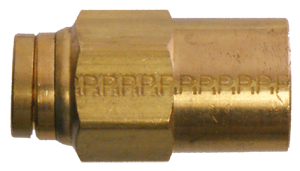Parker D.O.T. Fittings: Compression vs. Push-to-Connect

 In most transportation applications there are clear advantages to using D.O.T. approved push-to-connect fittings over compression fittings.
In most transportation applications there are clear advantages to using D.O.T. approved push-to-connect fittings over compression fittings.
While push-to-connect fittings typically cost more than compression fittings, quicker installation, less maintenance and less chance for leakage can make up for a higher purchase price. Additionally, the compact design of push-to-connect fittings is ideal for precise positioning in tight places.
 Compression fittings are available in more sizes and configurations than push-to-connect fittings. Some compression fittings can support a higher PSI rating than their push-to-connect counterparts.
Compression fittings are available in more sizes and configurations than push-to-connect fittings. Some compression fittings can support a higher PSI rating than their push-to-connect counterparts.
Compression fittings also require the use of tools to install, whereas push-to-connect fittings can be easily installed or removed without using tools, minimizing the chance of damaging equipment.
The nut on a compression fitting must be tightened correctly in order to create a seal and guard against leakage. With push-to-connect fittings, there are no compression nuts that need to be tightened. Simply pushing the fitting onto the hose or tube creates a leak free seal.
Compression fittings sometimes need to be retightened to prevent or to halt leaks. Push-to-connect fittings typically do not need readjusting in order to remain leak free.
When deciding which transportation fitting is right for your vehicle you must take into consideration:
- Pounds per square inch (PSI) pressure requirements
- Thread type needed
- Type of tube or hose that you are connecting the fitting to
Also refer to your owner’s manual for your specific application.
For a clear comparison of the transportation fittings reviewed in our prior blog posts “Selecting a Parker D.O.T. Approved Push-to-Connect Air Brake Fitting” and “Choosing Compression Transportation Tube & Hose Fittings,” please refer to the table below.
|
Transportation Fitting Name |
*Transportation Fitting Type |
Thread Type Available |
Pressure (PSI) |
Tubing or Hose Type |
| NTA | Compression | Straight Thread & Pipe | Up to 150 | SAE J844 Type A & B Tubing |
| Transmission | Compression | Pipe only | Up to 150 | SAE J844 Type A & B Tubing |
| AB | Compression | Straight Thread & Pipe | Up to 400 | SAE J844 Type A & B, Copper, Nylon w/ Tube Support |
| Air Brake Hose Ends | Compression | Straight Thread & Pipe | Up to 225 | Parker 271 Hose |
| Vibra-Lok | Compression | Straight Thread & Pipe | 100 to 1000 - depending on size & vibration | Copper, Aluminum, Steel (Bundy), Stainless Steel & Glass |
| Prestomatic | Push-to-Connect | Pipe & Metric | Up to 250 | SAE J844 Type A & B Tubing |
| PTC Composite | Push-to-Connect | Pipe only | Up to 250 | SAE J844 Type A & B Tubing |
| Metric Prestomatic | Push-to-Connect | BSPT & Metric | Up to 250 | DIN 73378 Virgin Nylon, SAE J844 Tubing |
*All compression and push-to-connect air brake fittings are D.O.T. approved.
Questions about Parker transportation fittings?
Posted by Linn Martinez




